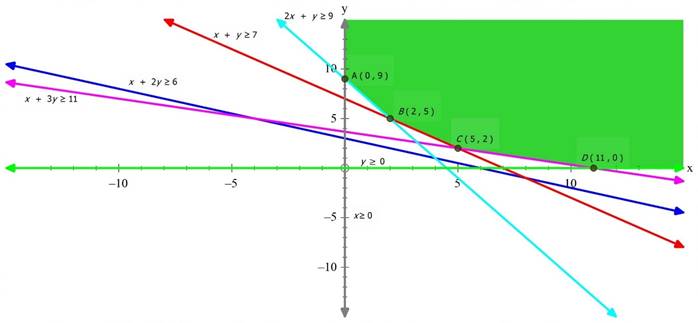A dietician mixes together two kinds of food in such a way that the mixture contains at least 6 units of vitamin A, 7 units of vitamin B, 11 units of vitamin C and 9 units of vitamin D. The vitamin contents of 1 kg of food X and 1 kg of food Y are given below :

One kg of food X costs ₹ 5, whereas one kg of food Y costs ₹ 8. Find the least cost of the mixture which will produce the desired diet.
The above information can be expressed with the help of the following table:

Let the quantity of foods X and Y be ‘x’ and ‘y’.
Cost of food X = 5x
Cost of food Y = 8y
Cost of the meal 5x+8y
Now,
⟹ x + 2y ≥ 6
i.e. the minimum requirement of Vitamin A in the foods X and Y is 6units, each of which has 1unit and 2 unit of Vitamin A.
⟹ x + y ≥ 7
i.e. the minimum requirement of Vitamin B in the two foods is 7units, each of which has 1 unit of Vitamin B.
⟹ x + 3y ≥ 11
i.e. the minimum requirement of vitamin C in the two foods is 11units, each of which has 1 unit and 3 units of vitamin C.
⟹ 2x + y ≥ 9
i.e. the minimum requirement of Vitamin D in the foods is 9units, each of which has 2 units and 1 unit of Vitamin D.
Hence, mathematical formulation of the LPP is as follows:
Find ‘x’ and ‘y’ that
Minimises Z = 5x + 8y
Subject to the following constraints:
(i) x + 2y ≥ 6
(ii) x + y ≥ 7
(iii) x + 3y ≥ 11
(iv) 2x + y ≥ 9
(v) x,y ≥ 0 (∵ quantity cant be negative)

The feasible region is unbounded.
The corner points of the feasible region are as follows:

Z is smallest at C(5,2)
Let us consider 5x + 8y ≤ 41.
As it has no intersection with the feasible region, the smallest value is the minimum value.
The minimum cost of the diet is ₹41